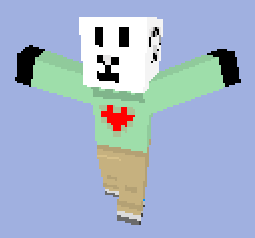Minecraft (Mojang, Java platforms)
Minecraft, although it is not advertised as a Christian game, is the first Christian game aimed at Secular gamers. And it's working!
There are two branches of Minecraft: Alpha, the main survival game, and Classic, which is more free-form. Both take place in a procedurally generated, natural world made entirely of blocks with low-res textures, like some sort of retro game, only 3D and huge (in Alpha the world goes on forever since it's generated on the fly as you travel.) Blocks can be taken from and added to the world to shape it as the player sees fit, although you need to make tools and gather supplies of blocks to do this in Alpha.
You start above ground in an outdoors environment filled with hills, mountains, oceans, grassy plains, sandy beaches, rocky outcrops, and forests. You can also dig into the ground and find caverns, underground waterfalls, and lava. Even though it's all low-res blocks it's really beautiful!

Minecraft uses procedurally generated worlds based on Intelligent
Design theory. Front-loading by the creator gives Minecraft worlds
specified complexity, just like the real world.
In Alpha, the player isn't told what to do or given any back-story, but it is clear to those familiar with the Bible that the game takes place in a world much like it was shortly after the Fall. The land is vast and unspoiled by human settlements, but death has entered the world. During the day you gather resources to build shelters and craft supplies. When night falls, demons appear and try to kill you.
At first glance the game doesn't appear overtly Christian, but the more you play the more it become apparent that the goal of its creator (a programmer named Notch) was to teach Biblical wisdom.
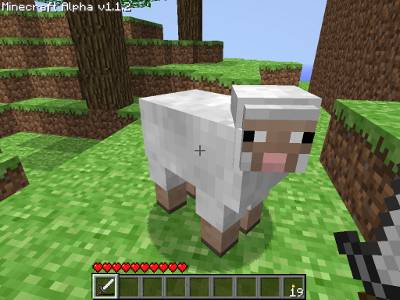
During the day, lambs frolic around the countryside,
reminding us of the Lamb of God.
Many lessons from the Bible are delivered to the player through intuitive immersion: For example, the player learns through trial and error to build his shelter on solid rock instead of falling sand, much as we should build our lives on the rock of Jesus. This is the same lesson taught in Matthew 7:24-27, however by engaging the player in actively experiencing the parable, the game subtly and effectively reaches Secular gamers who might otherwise reject explicit witnessing.
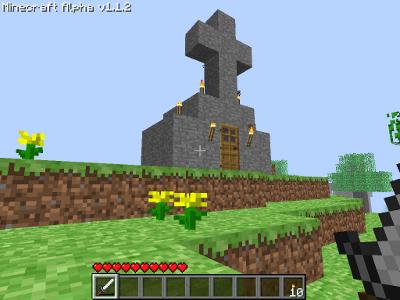
"I will liken him unto a wise man, which built his house upon a rock."
One of the central lessons comes when the player realizes that the most important thing to craft in the game are torches. Demons can spawn anywhere there is darkness, like at night or in caves. Torches keep this from happening, conveying the importance of light in a dark world. This makes the player more receptive to the good news that Jesus is the light: "I am come a light into the world, that whosoever believeth on me should not abide in darkness" (John 12:46) and "I am the light of the world: he that followeth me shall not walk in darkness, but shall have the light of life" (John 8:12).
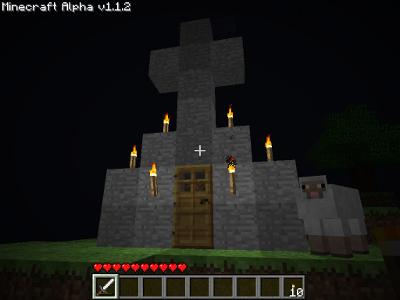
Building shelter and torches will protect you from the darkness.
(That's a sheep on the right. They are attracted to light, as
we should try to be too.)
Just like in real life, wandering around Minecraft in the dark is a sure way to fall victim to demons. Again, this conveys Jesus' teachings: "If any man walk in the day, he stumbleth not, because he seeth the light of this world. But if a man walk in the night, he stumbleth, because there is no light in him" (John 11:9-10). The demons' fondness for darkness and spontaneously combusting in sunlight are also Biblically founded: "They are of those that rebel against the light; they know not the ways thereof, nor abide in the paths thereof ... For the morning is to them even as the shadow of death: if one know them, they are in the terrors of the shadow of death" (Job 24:13,17).
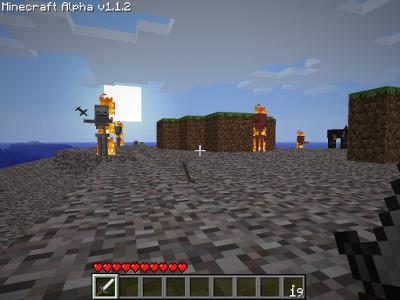
Demons burst into flame when exposed to daylight (Job 24:17).
In the beginning, the player is fearful of darkness, but soon learns that light provides safety and his fears subside: "The Lord is my light and my salvation; whom shall I fear? the Lord is the strength of my life; of whom shall I be afraid?" (Psalm 27:1).
The Biblical themes of solidness of rock and righteousness of light are central to Minecraft's gameplay. Even the most Secular of gamers will have these values instilled in them effortlessly without realizing they are learning the Gospel.
Another Biblical theme is Spiritual Warfare. Eventually the player is able to craft armor and a sword. This is necessary to survive the scariest of the demons, the creeper, which can silently sneak up on you and explode. Unlike other demons, creepers can survive sunlight without burning, teaching the player the value of putting on the Full Armor of God in order to engage demonic powers (Ephesians 6:10-18).

Learn to combat demonic creepers with the Sword of the Spirit,
a useful life skill.
(And back to the theme of light, another enemy, the giant spiders, can also survive in the day. But sunlight makes them become peaceful, showing how the light of Jesus can transform even the most wicked among us.)
To reach the Secular gamers who would never play an explicitly Christian game, Minecraft needs to be subtle and non-threatening, teaching Christian values without scaring off those whose hearts have been hardened by years of anti-Christian conditioning. Still, there are clues to the Christian purpose of the game. The most obvious is the name: Minecraft Alpha. This is of course a reference to Jesus' revelation that He is the Alpha and the Omega (Rev. 22:13). Also, the only animals in the game you can kill for food are pigs. This emphasizes the New Covenant with Jesus where we can now eat delicious ham -- a common ground we share with most Secularized people.
The other branch of Minecraft, Classic, doesn't have demons, darkness, torches, or many other Gospel elements that Alpha has. Instead, you are simply allowed to build whatever you want using an infinite supply of all types of blocks. This branch, based on an earlier version of the game, is free to play online and the multiplayer mode of it has a more social feel, kind of like a chat room where you can build things.

Classic multiplayer is a great tool for reaching the unsaved.
It's this multiplayer mode, in both Alpha and Classic, that's the true strength of Minecraft as not just a Biblical game, but a witnessing platform. Once Secular gamers are hooked on the innovative, open-ended, gameplay and have had many key Biblical values sowed in their minds, then they will be receptive to being approached by Minecraft missionaries in the multiplayer servers. Here is the real beginning of Salvation for these lost gamers, as they discover how the values they learned playing Minecraft apply to the Truth of God's plan for us all.

Me trying some Minecraft Missioning. pantz4lyfe was happy to
hear about Jesus... and later became born again!
It really works!
Minecraft Alpha is still under heavy development, with many more improvements and features planned. You can pre-purchase it now for half off the price of the final version (about $13.50). It's already a hit among Secular gamers and probably the biggest cross-over game on the Christian market today. Even though it is still a work in progress, I'm giving it †††††. It is an excellent game that teaches core Biblical values and represents the future of online Evangelism.
Update: Download the exclusive Lambuel Minecraft skin:
Update (11.2.2010): On Sunday a new Minecraft version (1.2.0) was released that increases the urgency of the game's message of Salvation by including the ability to witness Hell first-hand.
(The game's creator, Notch, was originally going to call this realm "Hell", but he thought that would make the Biblical origins of the game too obvious to the religion-averse unsaved gamers he's trying to reach, so he used the euphemism "Nether".)
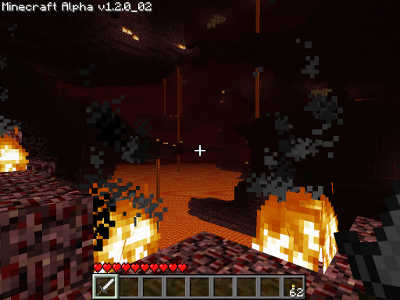
Everything is on fire!
The Nether (Hell) is presented as a vast underground cavern composed of brimstone with lakes of fire (Rev. 20:10), without light (Mat. 8:12) except for the fires that burn everywhere. Fire is the central theme of this realm. You even travel there by building a portal out of obsidian and lighting it on fire.
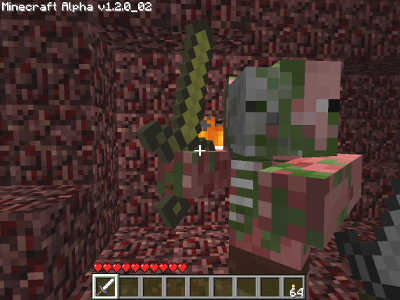
Don't let this happen to you!
The unsaved wander around Hell in constant torment, their corrupted flesh eaten by worms (Mark 9:44) as they wail and purr in madness (Mat. 13:50). Pale demons (Rev. 6:8) patrol the cavernous skies spitting explosive fireballs at you. There is no water here to quench your thirst (Luke 16:24). If you bring some in a bucket and try to use it, it just evaporates.
Minecraft's Biblically accurate vision of Hell is very disturbing and scary and will convince any unsaved person of the necessity of accepting Christ into their hearts before it is too late.

I caught another one!
Another new Biblical feature is a fishing minigame (Luke 5:1-11), which adds fish to the already existing loaves of bread as the most reliable sources of sustenance (Mat. 14:13-21, etc.).
Update (9.26.2011): Minecraft continues to be updated as the official release approaches. It's now up to version 1.9 (or at least the pre-release of 1.9). Besides lots of improvements in the technology such as a new lighting system, and more building materials such as pistons, Notch has added new mobs that further flesh out his vision of delivering Biblical teachings through interactive allegories.
Most interesting are the Endermen. The name is a portmanteau of "end of men", meaning the end of Man's stewardship over Earth, which the player's activity represents, and the beginning of the new Kingdom of God after Jesus returns. The Endermen come in the night and steal your blocks, causing destruction to your buildings. This is a clear reference to the analogy from 1 Thessalonians 5:2-4 of the day of the Lord coming "as a thief in the night" and bringing sudden destruction to the unsaved. Also, the Endermen drop "enderpearls", which if you use on a pig will do absolutely nothing (a clear reference to Matthew 7:6).
A more vaguely Biblical mob is the Blaze, which seems to be a simplified, blocky version of the whirlwind of fire from Ezekiel 1:4 that marks the arrival of God's battle chariot. This was just added to the pre-release so it doesn't do much yet other than shoot fire and drop blaze rods, which might be a reference to the golden measuring rod that Jesus uses in Revelation 21:15 to measure New Jerusalem. It's a bit confusing, but I'm sure Notch is going somewhere with this. Maybe it'll be clearer in 1.10.
Much less vague are the villager mobs which appear in procedurally generated villages. They wear monk-like robes and are all currently named "Testificate" (ie. "one who testifies"... maybe a little too on the nose there, Notch ;) but this name will be replaced with their jobs, one being a priest. Again, these were just added and they don't do anything, but Notch has said that they will assign missionary work. Also, since they seem like Catholic mobs, what with having a priest and the Latin "Testificate", perhaps you have to convert their villages. I'm sure we'll learn more in future updates.
Similar to the villages are the strongholds, which are underground. They are in a state of ruin and populated with the usual zombies, skeletons and creepers, plus a new mob, silverfish (which are not true fish, which represent Jesus, but deceitful insects). This addition, and especially the use of the name "stronghold", is very telling as this can only be a reference to the Spiritual Strongholds that we erect to protect us from pain, that we must tear down in order to free ourselves from the clutches of Satan. Notch has said that there will be bosses in the strongholds that you must defeat. Devils perhaps? Combined with the silverfish swarming out of the walls when you try to break them, hindering you from tearing down the stronghold, we're definitely getting into some seriously deep Spiritual Warfare allegory here!
The most exciting news is that Notch has promised there will be end game content, so adding all this up, perhaps what we're seeing are the building blocks (pun intended!) for a game about the return of Jesus and the establishment of His Kingdom on Earth! Could this be what Notch had planned all along? All the unsaved who have been playing will be so pleasently surprised when they hear the good news!
Unfortunately I need to address a rumor that has been going around about Minecraft. Some people have been writing me to say that Notch is really an Atheist. Apparently they heard this on something called "Twitter", which is like a Secular version of Christianchirp. I got permission from Pastor Hoskins to use his unfiltered computer to check this out and what I found out was that there are a lot of people creating fake Notch accounts on Twitter, like "Communist_Notch" and "Lying_Notch", and writing all sorts of silly or even offensive things, including that he's an Atheist. The people behind this have even set up a blog called "The Faces of Notch" [NSFC] telling people how to make fake Notch accounts to cause mischief and confusion. Don't be fooled by these fake Notchs! Notch's game and the Christian themes woven into it speaks for itself.
Update (2.10.2012): I have troubling news about Minecraft. The game has been hijacked! Notch, the man who created Minecraft single-handedly and whose vision of a game that teaches the Gospel to the unsaved in a non-threatening manner made it a cross-over hit, has been pushed out of control of Minecraft's development by the people running Mojang, the company he formed with the profits from Minecraft. (Notch wasn't the CEO of Mojang since he just wanted to work on making games. He hired someone to be his boss. Bad idea?)
The game's now under the control of a guy named Jeb Bergensten. Since Jeb was hired last year by Notch to help out with development, he has been adding all sorts of questionable content, like occultic "enchantments" of weapons using the captured souls of demons, and drug labs that let you brew amphetamine-like drinks. Now he's been put in charge of the game and Notch is no longer allowed to work on it.
The last thing that Notch added before he was removed from development was a final goal you had to work toward where you must travel to the End (ie. the End Times) and defeat the Dragon (ie. Satan, see Rev. 12-13). Could this less cryptic Biblical content have been the cause of his removal?
I don't know what's going on at Mojang. Has there been a coup? Is Notch OK? His Twitter account, which is probably under the control of Mojang, is filled with all sorts of strange messages that sound like the fake Notches mentioned above, with Atheist stuff and.. weird math or something. Did anti-Christians realize the threat that Minecraft posed to their hold on the mainstream game industry and seize control to pervert the true meaning of Minecraft?
If anyone can contact Notch, the real Notch, please find out what is going on.. and please pray that he is OK!

